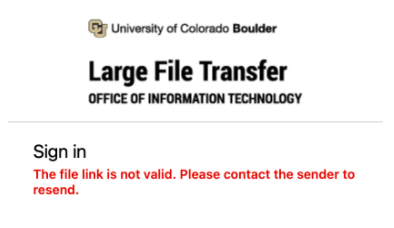General FAQ
How do I log in?
Go to https://filetransfer.colorado.edu and log in using your IdentiKey@colorado.edu email address and IdentiKey password or the account information you've already set up. Visit the Large File Transfer - Log in tutorial for more information.
Please note: the LFT service uses Multi-Factor Authentication for secure login. To edit or change your multi-factor authentication settings, please visit the Register and Set Up MFA or the Set up Microsoft Authenticator App tutorial.
What is Accellion?
Accellion is the company that provides the service functionality. The server and all of the data is located on-campus.
What are the major differences between the Accellion FTA and Kiteworks platforms?
The biggest difference you will notice in using Kiteworks is the interface. The web client has been simplified so that all functions are available from a single window. The FTA had tabs at the top of the windows to switch between managing and sending files, whereas Kiteworks looks more like a traditional web email client.
The FTA provided the ability to create “workspaces”, which was intended to allow people to share and collaborate on shared files securely. In Kiteworks, that functionality is achieved via “Shared folders”. In the FTA, anyone could create a Workspace. On the new platform, OIT is requesting that people who need to use the shared folder functionality make a request using the Request a shared folder form so that we can track usage and assign the appropriate user profile.
Why would I use the CU Boulder Large File Transfer Service?
The Large File Transfer Service allows Boulder campus faculty, staff and student employees to safely send files that are larger than the email attachment size limitation; usually around 50MBs. Files are transferred over an encrypted channel.
How long is my file available for download by the person I sent it to?
Once the recipient has been notified that a file is ready to download, they have 14 days to retrieve it. It can be downloaded as many times as is necessary in those 14 days. In the event that the Large File Transfer service’s software must be rolled back to an earlier version, files may not be preserved.
Is there a file size limit for this service?
There is no limit on the number of files you can send, and technically there is no file size limit. However, there is a limited amount of storage available for all users of the service. Please contact us if you are planning to share files greater than 200GB in size.
Who can send files through the Boulder Campus Large File Transfer Service?
Boulder Campus faculty, staff, and student employees can initiate file transfers to any email address. If you fall into one of these categories but are unable to use the service, contact the IT Service Center to get access. User accounts pre-registered for the service based on employment status at the Boulder campus.
Who can I send files to?
Any CU Boulder employee can send a file to any individual, on-campus or off-campus, with an email address. The service will not send files to email lists.

